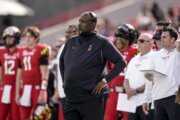In a letter to NCAA membership Friday, President Charlie Baker said a preliminary approval hearing for a landmark $2.78 billion antitrust settlement “did not go as we hoped” and that the association and major college conferences are trying to address the judge’s concerns about parts of the proposed deal.
The settlement agreement college sports leaders believe is vital to transform the enterprise, get out from under the constant threat of litigation and avoid a potentially crippling financial outcome at trial ran into a stumbling block Thursday night.
U.S. District Judge Claudia Wilken not only declined to grant preliminary approval, but she sent the two sides “back to the drawing board” and asked them to report back in three weeks with answers to her questions.
“Last night’s hearing did not go as we hoped. The court posed worthwhile questions that the NCAA began working through immediately last night with our partners in the conferences,” Baker wrote in the letter obtained by AP.
Wilken took issue with several elements of the agreement, but her dismay with a plan to regulate and potentially restrict third-party name, image and likeness payments to athletes from booster-funded collectives created by far the most significant hurdle to the settlement.
“What are we going to do with this?” Wilken asked. “I found that taking things away from people is usually not too popular.”
Collectives in spotlight
So-called NIL collectives have become the No. 1 way college athletes can cash in on use of their fame. According to Opendorse, a company that provides NIL services to dozens of schools, 81% of the $1.17 billion spent last year on NIL deals with college athletes came from collectives.
The plaintiffs and defendants in the case contend any limits on athlete earning potential are easily offset by a proposed revenue-sharing plan that is also part of the settlement.
“We believe the proposal offers both sides the best possible alternative to endless litigation: Student-athletes receive landmark financial benefits plus the ability to monetize their name, image and likeness rights without limitation, and the colleges and universities that combined deliver nearly $4 billion in scholarships and millions more in health, wellness and educational benefits to hundreds of thousands of young people every year receive stability,” Baker said. “The proposal allows both sides to build a system that’s sustainable for years to come.”
Steve Berman, the Seattle-based plaintiffs’ attorney who negotiated terms of the proposed settlement, said his confidence level remains high a deal will be approved.
“At the beginning of the hearing it’s clear Judge Wilken understood the seismic shift this settlement brings to athletes,” he told AP Friday. “She may have to decide if the billions that will go to athletes should not go forward because of this one restriction.”
Getting around the cap
The revenue-sharing plan that was negotiated in the settlement mimics salary caps used in professional sports leagues to create competitive balance. Each school would be will be permitted to spend up to about $21 million per year on payments to their athletes, divvied up among sports at their discretion.
The concern among some college administrators is that collectives will be used to essentially circumvent that cap and give the schools that have the most aggressive or wealthiest boosters an advantage when it comes to acquiring talent.
Some would argue it has always been that way in college sports, whether it’s under-the-table payments or the very-much-above-board funding of opulent athletic facilities and astronomical salaries for coaches.
Reining in collectives
The settlement plan calls for “certain new rules limiting boosters to making fair market value payments for NIL” and somehow ensuring NIL deals are “for a valid business purpose related to the promotion or endorsement of goods or services provided to the general public for profit, with compensation at rates and terms commensurate with compensation paid to similarly situated individuals with comparable NIL value who are not current or prospective student-athletes at the Member Institution.”
Plaintiffs’ attorneys told the skeptical judge during Thursday’s hearing this would have no impact on endorsement deals athletes might make with big companies such as Nike or Coke.
Berman said the settlement agreement failed to thoroughly explain the purpose of the proposed restrictions.
“So before, collectives were recruiting players with cash payments. Now the schools have the option to pay players as they see fit in a competitive market,” Berman told AP. “The NCAA doesn’t want booster pay-for-play in addition now that players can get paid directly by schools. So making collectives stick to bona fide NIL deals seems a fair compromise to have some pay-for-play limits after all the pay rules have been upheld by Judge Wilken twice.”
Reporting and enforcement
The settlement calls for athletes to disclose deals over $600 with collectives or boosters, and those deals would be subject to review through an arbitration process. Enforcement will be taken out of the NCAA’s hands to a certain extent.
“That is an improvement from the student-athlete’s perspective on the status quo,” NCAA lead counsel Rakesh Kilaru told Wilken. “If the NCAA enforced tomorrow against an institution or a student-athlete for an improper booster payment, that would have immediate effect.”
Kilaru conceded removing the booster restrictions from the proposal could be a deal breaker.
The NCAA was forced to back off a crackdown on collectives using payments as recruiting inducements (a rule still on the books), when it was sued by the states of Tennessee and Virginia following an NCAA inquiry into deals made by a Tennessee-focused collective.
For those who work in and for collectives, Wilken’s rebuke was a bit of vindication.
“Anybody who read the proposed settlement could see that this was problematic,” said Russell White, who leads The Collective Association. “This was another attempt by the NCAA to limit financial opportunities for college athletes and take back power that they’ve lost over the past years.”
What now?
Preliminary approval is an important step. Parties can file objections to the agreement after preliminary approval; Wilken signaled in the hearing to some that have already filed objections that she did not find their arguments persuasive.
Her own concerns seem more likely to derail the plan, though Wilken said she believes it is “likely enough that there will be a settlement” and the NCAA noted the questions raised by the judge “are not uncommon in the context of class-action settlements.”
The soonest Wilken could grant final approval is 150 days after notices go out to members of the damages class, which numbers more than 400,000 athletes dating to 2016. But now it will be at least another three weeks before any movement.
____
Follow Ralph D. Russo at https://twitter.com/ralphDrussoAP
___
Get poll alerts and updates on the AP Top 25 throughout the season. Sign up here. AP college football: https://apnews.com/hub/ap-top-25-college-football-poll and https://apnews.com/hub/college-football
Copyright © 2024 The Associated Press. All rights reserved. This material may not be published, broadcast, written or redistributed.





